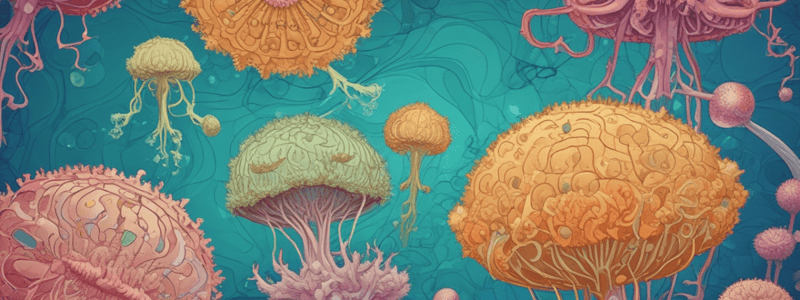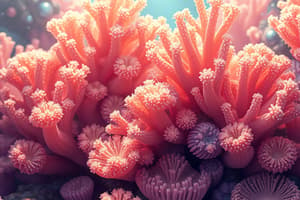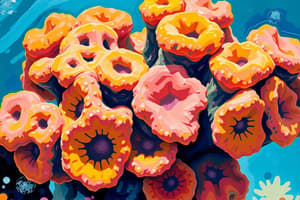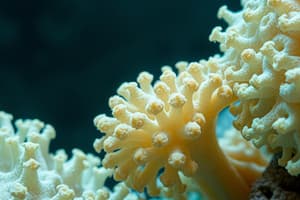Podcast
Questions and Answers
What do molecular phylogenetic analyses suggest about the relationship between choanoflagellates and animals?
What do molecular phylogenetic analyses suggest about the relationship between choanoflagellates and animals?
- Animals evolved directly from sponges.
- The common ancestor of animals was a multicellular protist.
- Animals are more closely related to plants than choanoflagellates.
- Choanoflagellates are the closest extant relatives of animals. (correct)
What feature do choanoflagellates and sponges share, based on cell morphology?
What feature do choanoflagellates and sponges share, based on cell morphology?
- Hard external skeletons.
- Photosynthetic capabilities.
- Flagella for movement.
- Funnel-shaped collar of microvilli. (correct)
What is a characteristic feature of choanoflagellates that helped in capturing bacteria?
What is a characteristic feature of choanoflagellates that helped in capturing bacteria?
- Photosynthetic organelles.
- Microvilli projections on the cell membrane. (correct)
- Flagellum for locomotion.
- Hard outer shell.
What is the approximate estimated timeframe for the evolution of sponges and the common ancestor of animal phyla?
What is the approximate estimated timeframe for the evolution of sponges and the common ancestor of animal phyla?
What is the significance of choanoflagellates resembling the ancestral protist?
What is the significance of choanoflagellates resembling the ancestral protist?
From which geological time period do molecular phylogenetic analyses suggest the common ancestor of animals and sponges evolved?
From which geological time period do molecular phylogenetic analyses suggest the common ancestor of animals and sponges evolved?
Which subphylum do Choanoflagellates belong to?
Which subphylum do Choanoflagellates belong to?
Which period saw the emergence of animals with complex organs and bilateral symmetry?
Which period saw the emergence of animals with complex organs and bilateral symmetry?
Which of the following is a shared, derived trait of Metazoan clades?
Which of the following is a shared, derived trait of Metazoan clades?
In terms of tissue composition, what sets Eumetazoa apart?
In terms of tissue composition, what sets Eumetazoa apart?
What type of symmetry is typical of Bilaterians?
What type of symmetry is typical of Bilaterians?
Why are choanoflagellates considered closely related to animals?
Why are choanoflagellates considered closely related to animals?
What advantage(s) does multicellularity provide, according to the text?
What advantage(s) does multicellularity provide, according to the text?
Which era marked the appearance of whole-body animal fossils dated around 560 mya?
Which era marked the appearance of whole-body animal fossils dated around 560 mya?
What geological period is associated with the earliest complex, multicellular animal fossils from the Ediacaran biota?
What geological period is associated with the earliest complex, multicellular animal fossils from the Ediacaran biota?
In what period did the rise of marine planktonic algae contribute to increased atmospheric and oceanic oxygen levels?
In what period did the rise of marine planktonic algae contribute to increased atmospheric and oceanic oxygen levels?
Which event enabled the emergence of various unicellular forms, including protists?
Which event enabled the emergence of various unicellular forms, including protists?
What is the primary evidence supporting choanoflagellates as the living sister group to Kingdom Animalia?
What is the primary evidence supporting choanoflagellates as the living sister group to Kingdom Animalia?
What is the main difference between animals from the Ediacaran period and those from the Cambrian explosion?
What is the main difference between animals from the Ediacaran period and those from the Cambrian explosion?
Which of the following is NOT a shared, derived trait of metazoan clades?
Which of the following is NOT a shared, derived trait of metazoan clades?
What is the significance of choanoflagellates in understanding animal evolution?
What is the significance of choanoflagellates in understanding animal evolution?
What is a characteristic feature of Eumetazoa that distinguishes them from other metazoan clades?
What is a characteristic feature of Eumetazoa that distinguishes them from other metazoan clades?
What provides evidence that choanoflagellates are closely related to animals?
What provides evidence that choanoflagellates are closely related to animals?
Which trait is a shared, derived feature of Metazoan clades based on the text?
Which trait is a shared, derived feature of Metazoan clades based on the text?
What characteristic feature distinguishes animals from the Ediacaran period compared to the Cambrian explosion animals?
What characteristic feature distinguishes animals from the Ediacaran period compared to the Cambrian explosion animals?
Why are choanoflagellates and animals hypothesized to share a common ancestor?
Why are choanoflagellates and animals hypothesized to share a common ancestor?
What feature is shared between choanoflagellates and sponge collar cells based on the text?
What feature is shared between choanoflagellates and sponge collar cells based on the text?
How did the early animals from the Ediacaran period differ from those in the Cambrian explosion period according to the text?
How did the early animals from the Ediacaran period differ from those in the Cambrian explosion period according to the text?
What is a key feature of choanoflagellate cells that supports their close relation to animals?
What is a key feature of choanoflagellate cells that supports their close relation to animals?
What distinguishes the Ediacaran biota from the Cambrian explosion?
What distinguishes the Ediacaran biota from the Cambrian explosion?
What is a shared, derived trait of Metazoan clades?
What is a shared, derived trait of Metazoan clades?
What geological era is associated with the rise of marine planktonic algae and increased atmospheric and oceanic oxygen levels?
What geological era is associated with the rise of marine planktonic algae and increased atmospheric and oceanic oxygen levels?
What is the estimated timeframe for the evolution of sponges and the common ancestor of animal phyla?
What is the estimated timeframe for the evolution of sponges and the common ancestor of animal phyla?
What characteristic of choanoflagellates supports their close relation to animals?
What characteristic of choanoflagellates supports their close relation to animals?
Flashcards are hidden until you start studying
Study Notes
Origin of Animals
- Kingdom Animalia includes a vast diversity of living and extinct species.
- Molecular phylogenetic analyses indicate that sponges and the common ancestor of other animal phyla evolved 670-700 million years ago (mya).
- This ancestral protist likely resembled modern choanoflagellates, which are flagellated eukaryotes.
Choanoflagellates
- Choanoflagellates are opisthokont protists that are the closest relatives of animals.
- Extant choanoflagellates are small unicellular, heterotrophic protists.
- Microvilli are finger-like projections of the cell membrane that captured bacteria.
- Choanoflagellates are collared flagellates (choano = collar), with a funnel-shaped collar of microvilli at the base of a flagellum.
- ~140 species living as unicellular and colonial forms (stalked or ball-like colonies) in marine and freshwater environments.
Evidence for Choanoflagellates as Animal Ancestors
- DNA sequence homology: Molecular phylogenies confirm choanoflagellates as the closest extant relatives of animals.
- Cell morphology: Choanoflagellate cells and the collar cells of sponges are almost indistinguishable.
- Unique cell morphology: Cells resembling choanoflagellates are found in other animals, but never in non-choanoflagellate protists, plants, or fungi.
Evolution of Multicellularity
- Evolution of eukaryotic cells enabled the emergence of various unicellular forms, including protists.
- Multicellularity evolved independently in multiple lineages, leading to the development of algae, plants, fungi, and animals.
- Evolutionary advantages for multicellularity: cell specialization, increased size and complexity, longer lifespans, and defence against predation.
Fossil Evidence
- Fossil evidence dates the oldest multicellular eukaryotes (algae) to ~1.2 billion years ago (bya), with molecular clock calculations suggesting an origin around 1.7 bya.
- Whole-body animal fossils date from ~560 mya (Neoproterozoic Era [late Proterozoic]).
- The earliest complex, multicellular animal fossils are from the Ediacaran biota (565 to 550 mya).
- The rise of marine planktonic algae (Archaeplastida) ~800–650 mya increased atmospheric and oceanic oxygen levels (Neoproterozoic Oxygenation Event).
Animal Characteristics
- Metazoa characteristics:
- True tissues, including muscle and nerve tissues
- Gastrulation
- Eumetazoa characteristics:
- Multicellularity and cell differentiation
- Cell adhesion (extracellular matrix)
- Sperm and ova (egg)
- Embryonic blastula
- Bilateria characteristics:
- Bilateral symmetry
- Triploblastic
- Complex organs
Studying That Suits You
Use AI to generate personalized quizzes and flashcards to suit your learning preferences.




